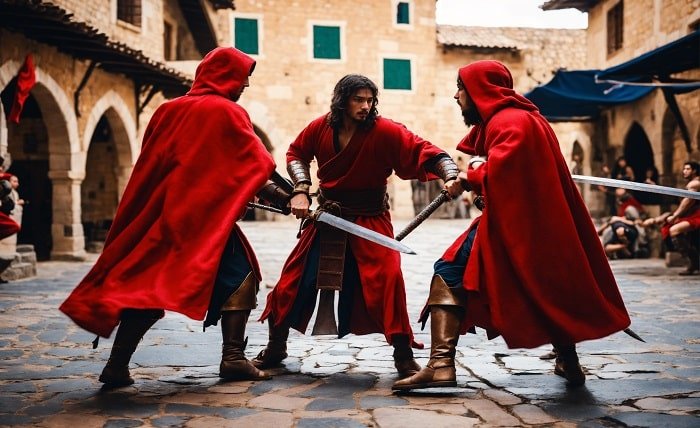The Cplemaire Duel du Tierce: A Historical and Cultural Exploration

Introduction
The “Cplemaire Duel du Tierce” is a term that sparks curiosity for many, but its true meaning and historical significance are often misunderstood. For those unfamiliar with it, the Cplemaire Duel du Tierce refers to a historic event or practice that blends the intensity of competitive rivalry with the complexity of strategy, often involving elements of chance, skill, and historical context. This post delves into the fascinating origins, development, and cultural relevance of the Cplemaire Duel du Tierce, shedding light on why it has remained an important part of historical conversations.
The Origins of the Cplemaire Duel du Tierce
To understand the full extent of the Cplemaire Duel du Tierce, we first need to explore its origins. The term “cplemaire” refers to a time period or season in which specific duels took place, possibly linked to a particular event in history, such as military or political contests. The “duel du tierce” implies a duel, often between two parties, with “tierce” indicating a third-party involvement or a significant external factor that influenced the outcome of the duel. Tracing its roots through historical texts and accounts, the Cplemaire Duel du Tierce became synonymous with fierce competition and was held in high regard for both its entertainment value and its deeper social significance.
The practice was predominantly popular in medieval and early modern Europe, where duels were more than just a physical battle. They were an outlet for settling scores, proving valor, and showcasing one’s mastery of particular skills. The Cplemaire Duel du Tierce was, therefore, not just a mere contest of physicality but also a demonstration of intelligence, strategy, and respect for a highly structured set of rules.
Key Features of the Cplemaire Duel du Tierce
What sets the Cplemaire Duel du Tierce apart from other historical duels is its unique blend of elements. At its core, this duel was not only about strength but also about carefully calculated tactics. Each duel followed a strict set of protocols, and the involvement of a third party, or “tierce,” played a pivotal role in determining the course of the event.
The third-party, often a neutral observer, had the responsibility of ensuring fairness. This figure would typically be a respected member of the community or a recognized expert in the field of dueling. Their role was crucial because the Cplemaire Duel du Tierce was designed not only as a test of individual skill but also as a means of maintaining social order and resolving disputes in a civilized manner. This set the Cplemaire Duel du Tierce apart from the more chaotic, uncontrolled duels of the time.
The Role of the Tierce in the Cplemaire Duel du Tierce
As indicated by the name, the “tierce” holds significant importance in the structure of this duel. The involvement of a third party in the Cplemaire Duel du Tierce was designed to ensure that the duel was fair and unbiased. The tierce’s role could range from acting as a referee to providing the final verdict in case of disputes. Their judgment was often considered absolute, and they held the power to determine whether a duel was fought to completion or whether it needed to be halted for any reason.
The tierce was typically someone who was not involved in the personal stakes of the duel, such as a respected military leader or a well-known expert in dueling traditions. Their experience and impartiality made them ideal candidates to oversee such critical events. The presence of a third party added a layer of accountability and ensured that the Cplemaire Duel du Tierce adhered to established codes of honor and conduct.
Cultural Significance of the Cplemaire Duel du Tierce
The cultural impact of the Cplemaire Duel du Tierce cannot be overstated. It served as a significant social event where the nobility, warriors, and even the common folk gathered to witness these epic contests. These duels were more than just physical competitions—they were also a display of societal values such as bravery, honor, and respect for tradition.
Throughout history, dueling was often a way for individuals to resolve disputes without resorting to full-scale violence or war. The Cplemaire Duel du Tierce provided a structured, rule-bound way for individuals to settle matters of honor, land disputes, or personal grievances. It became an essential part of the social fabric, particularly in European societies where codes of chivalry and honor were highly prized.
The Decline of the Cplemaire Duel du Tierce
Despite its cultural and historical significance, the Cplemaire Duel du Tierce eventually saw a decline. As societal norms changed, and the role of dueling in resolving conflicts became more controversial, these events began to lose favor. The rise of legal systems and state-controlled mechanisms for conflict resolution played a crucial part in diminishing the popularity of the Cplemaire Duel du Tierce.
Additionally, the increasing presence of firearms and other modern weaponry made the traditional dueling methods obsolete. The structure of the duel, as defined by honor and precision, struggled to adapt to the brutal realities of modern warfare. The Cplemaire Duel du Tierce, like many other traditional practices, was eventually replaced by new forms of conflict resolution and entertainment.
The Lasting Legacy of the Cplemaire Duel du Tierce
Although the Cplemaire Duel du Tierce no longer holds the same cultural significance it once did, its legacy lives on. The tradition of dueling, while no longer a common practice, has had a lasting influence on modern storytelling, particularly in literature and film. Many of the themes surrounding duels—honor, rivalry, and the role of a neutral third party—continue to resonate in contemporary media.
Moreover, the Cplemaire Duel du Tierce remains a subject of interest for historians, scholars, and enthusiasts of medieval and early modern culture. The study of such practices offers valuable insights into the values and conflicts that shaped past societies, and it serves as a reminder of the ways in which humans have sought to resolve their differences throughout history.
Conclusion
The Cplemaire Duel du Tierce represents a fascinating chapter in the history of dueling, where skill, strategy, and honor were paramount. The combination of a duel with the involvement of a neutral third party set this practice apart from others, adding layers of complexity and accountability. Although this tradition has faded from modern society, its influence can still be felt in various aspects of contemporary culture. By understanding the historical context of the Cplemaire Duel du Tierce, we gain a deeper appreciation for how past societies navigated conflict and maintained order in a turbulent world.
FAQs
1. What is the Cplemaire Duel du Tierce?
The Cplemaire Duel du Tierce refers to a historic duel involving two parties, with a third party acting as a neutral referee to ensure fairness and uphold honor.
2. Why was the third party (tierce) so important?
The tierce ensured that the duel was fair, unbiased, and adhered to established codes of conduct. Their role was crucial in maintaining order during the event.
3. When did the Cplemaire Duel du Tierce originate?
The practice originated in medieval and early modern Europe, where duels were a common way to resolve disputes and demonstrate personal valor.
4. How did the Cplemaire Duel du Tierce differ from other duels?
Unlike other duels, the Cplemaire Duel du Tierce involved a third-party referee, making the event more structured and accountable.
5. What is the legacy of the Cplemaire Duel du Tierce?
The Cplemaire Duel du Tierce has left a lasting impact on literature, film, and historical studies, continuing to influence cultural depictions of honor and rivalry.





